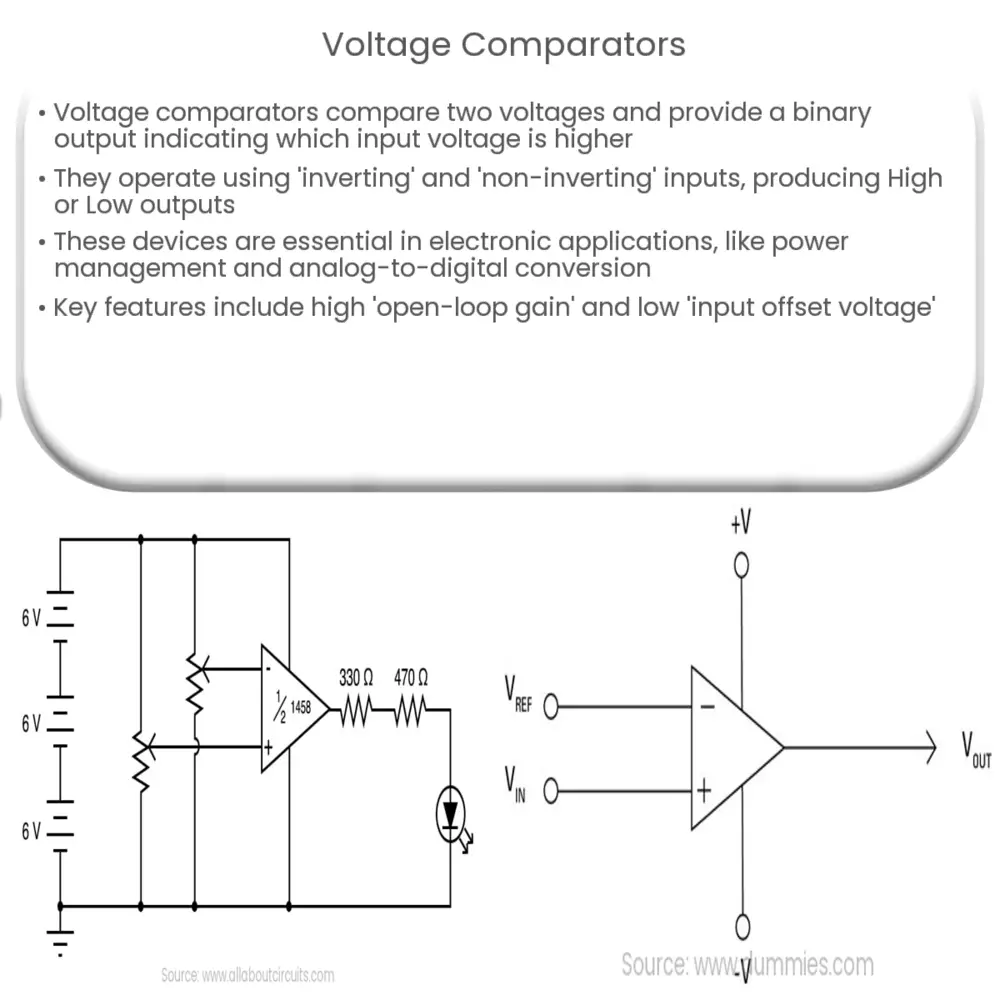Explore the fundamentals of voltage comparators, their operational principles, applications, key features, and design considerations in modern electronics.

Understanding Voltage Comparators
A voltage comparator is an electronic device designed to compare the magnitudes of two voltages. It takes two inputs, compares them, and provides a binary output that indicates which of the input voltages is higher. The basic operation of a voltage comparator can be explained through a metaphor: if it were a race between two voltages, the voltage comparator would be the judge determining which voltage arrived first.
Operational Principles
The operational principle behind a voltage comparator is straightforward. It has two inputs: the ‘inverting input’ and the ‘non-inverting input’. The comparator output depends on the difference between these two inputs. If the non-inverting input (V+) is greater than the inverting input (V–), the output is High. Conversely, if the inverting input is greater, the output is Low.
Real-World Applications
-
Voltage comparators find use in numerous electronic applications, such as power management circuits. They can serve as under-voltage or over-voltage detectors, shutting down a system or triggering an alarm if voltage levels fall outside of a predefined safe range.
-
They are also used in analog-to-digital converters (ADCs). By comparing the input voltage to a reference voltage, an ADC can convert an analog signal into a digital one, essential in many modern electronic devices.
-
Moreover, voltage comparators are used in oscillator circuits, which generate a continuous output waveform. By rapidly switching between high and low output states, a voltage comparator can produce a square wave signal.
Key Features of Voltage Comparators
Voltage comparators exhibit some essential features that make them highly useful in electronic circuits. One key aspect is the ‘open-loop gain’, which can be extremely high, often in the order of 105 to 107. This means that even a small difference between the input voltages will result in a significant difference in output voltage, effectively amplifying the input signal. Another crucial feature is the ‘input offset voltage’, which is the voltage that must be applied to one input to make the comparator output switch state when the other input is grounded. This value is usually very small, ensuring that the comparator can respond to minute differences in input voltages.
Types of Voltage Comparators
Voltage comparators are broadly categorized into two types: standalone and integrated in operational amplifiers (op-amps). Standalone comparators are designed specifically for comparison tasks, and they often exhibit higher speeds, lower input offset voltages, and more robust handling of overdrive conditions. On the other hand, op-amp comparators have the advantage of being part of a larger, more versatile device.
Comparator Design Considerations
When designing circuits that utilize voltage comparators, a few critical factors should be considered:
-
Speed: This refers to how quickly the comparator can respond to changes in input voltages. It is a crucial factor in applications where rapid voltage changes occur, such as in high-frequency oscillators or fast ADCs.
-
Power Consumption: Lower power consumption is always desirable, especially in battery-powered devices. Some comparators offer power-saving modes to help mitigate energy use.
-
Hysteresis: This is a feature that prevents the comparator from rapidly toggling its output when the input voltages are very close to each other. It is essential to reduce the effects of noise and provide a stable output.
Commonly Used Voltage Comparators
-
The LM311 is a popular standalone comparator due to its high speed, low power consumption, and ability to drive different types of loads.
-
The LM339 is another commonly used comparator. It has four comparators in one package, making it ideal for applications that require multiple comparison points.
Conclusion
Voltage comparators are critical components in modern electronics, used to compare two voltage levels and provide a high or low output accordingly. With their broad range of applications, from power management circuits to analog-to-digital converters and oscillators, understanding their operation principles, key features, and design considerations is valuable for anyone in the electronics field. Whether it’s the standalone or the op-amp integrated types, the choice of comparator would depend on the specific requirements of speed, power consumption, and noise immunity, among others. Truly, the humble voltage comparator is a small component that plays a big role in our increasingly digital world.

